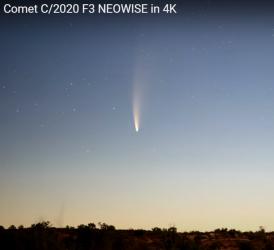 On March 27, astronomers discovered a new comet that they designated C/2020 F3. The comet was located using NASA’s space telescope, the Near Earth Object Wide-field Infrared Survey Explorer (NEOWISE), the comet is being called Neowise. While not one of the brighter comets, like Hale-Bopp, the great comet of 1997,” nevertheless Neowise should be visible with the naked eye until early August. Let’s hope that the ancient lore of comets as harbingers of doom does not apply. We have had enough ill-fortune in 2020 already.
On March 27, astronomers discovered a new comet that they designated C/2020 F3. The comet was located using NASA’s space telescope, the Near Earth Object Wide-field Infrared Survey Explorer (NEOWISE), the comet is being called Neowise. While not one of the brighter comets, like Hale-Bopp, the great comet of 1997,” nevertheless Neowise should be visible with the naked eye until early August. Let’s hope that the ancient lore of comets as harbingers of doom does not apply. We have had enough ill-fortune in 2020 already.
The Washington Post reports: Through the weekend, your best bet to catch Neowise would entail sauntering outdoors to a dark location about an hour before sunrise. Neowise won’t be too high above the horizon, so ensure that you have a clear, unobstructed view. But look to the east-northeast, and you’ll catch the starlike comet with a blurred tail smudged upward and right.
“[I]t’s dim so finding that sweet spot between it rising shortly after 4 a.m. when the sky is really dark, and 5 a.m. when it’s above the treeline but it begins getting lost in the twilight, is key to seeing it,” wrote NASA ambassador Tony Rice in an email.
From mid-July to mid-August, look to the west-northwest after sunset—between the stars of the Big Dipper—and keep an eye out for a fuzzy, bright object with a long orange tail, reports Dan Falk for National Geographic. Scientists recommend using binoculars or a telescope to get a clearer view, writes Eddie Irizarry for EarthSky. Up close, you might even be able to spot the comet’s forked tail. One part of the comet’s spliced tail is made primarily of gases, while the other is made up of dust, per the Post.
NEOWISE will move closest to Earth on July 22, flying just 64 million miles above the planet’s surface, according to EarthSky, according to the Smithsonian.
If you do not have the opportunity to see the new comet here is a time-lapse video of Neowise, shot by Chaotic Horizons. Thanks to Phil Stone for contributing to this post.

Fascinating